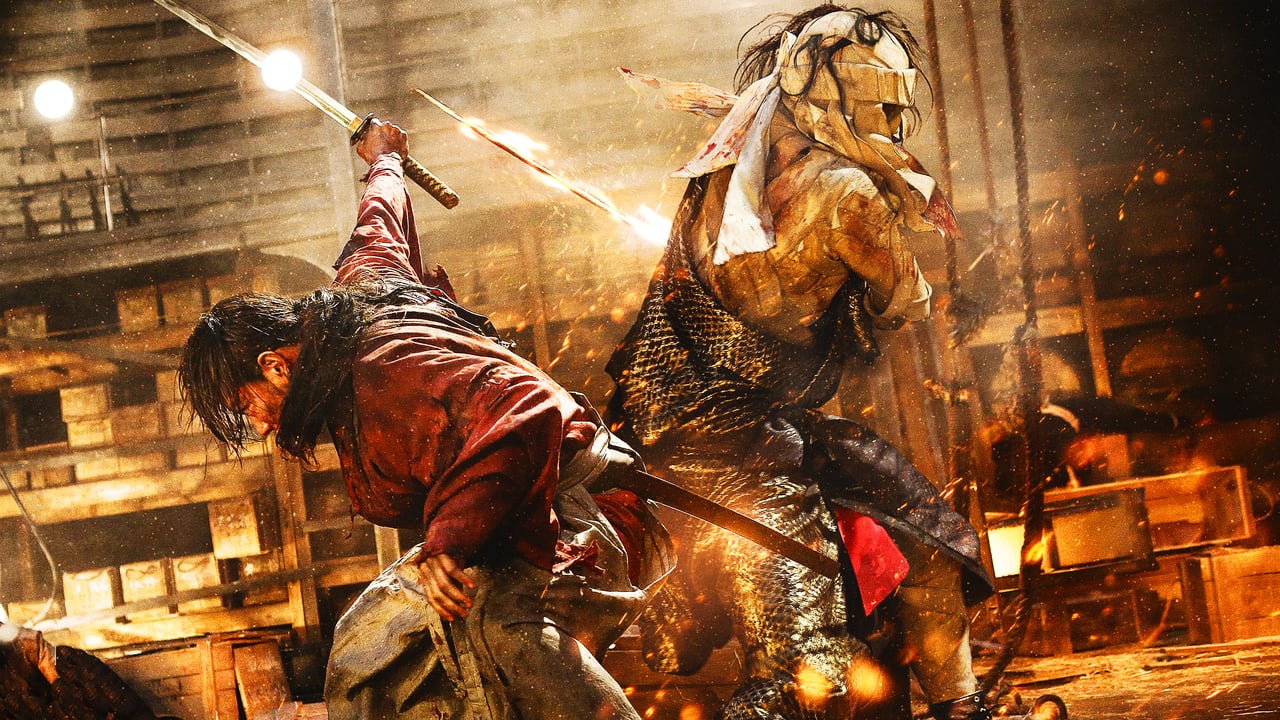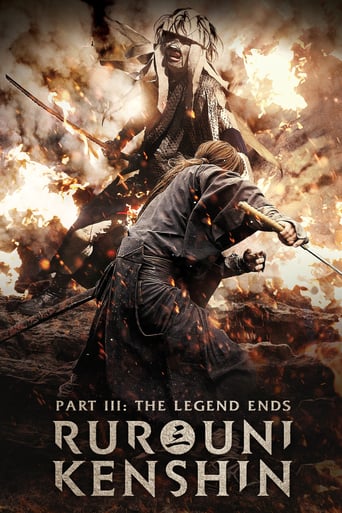



i must have seen a different film!!
If the ambition is to provide two hours of instantly forgettable, popcorn-munching escapism, it succeeds.
View MoreThere's no way I can possibly love it entirely but I just think its ridiculously bad, but enjoyable at the same time.
View MoreThis is a dark and sometimes deeply uncomfortable drama
View MoreI've read a few reviews on here about how wishy-washy the action was and the twisting of the plot. As a super fan of Samurai X, I really see no other way of having recast this story without overkill of CGI and long meandering plots. I doff my cap to the producers of this as trying to remake the history up Battousai, leaing up to the final battle with Shshio, was no mean feat. The character replications are exemplary, the sword fights are memorable and even some of the remakes of Kenshin's signature moves are brought to life in the most realistic ways possible. Condensing a series that went 96 episodes + 4 OVAs each going on average 23 min (though up to the Shishio battle would be about eps 50 something) into a trilogy of 2hr 15 min each is not easy, especially while trying to build some level of intimacy and depth with the characters is not easy.Cons: I' have loved them to develop some characters further, or give the backstory at least (Sojiro, Aoshi and some of the Juppongata) to create more drama and depth, as well as inclide some more epic fight scenes.Overall: 8/10
View MoreA reflective first act may prove to be too slow for some viewers, but these moments contain the most imperative lessons for Kenshin in the entire trilogy. This film contains-easily one of the greatest third acts I've ever seen, and any martial arts/action film buff worth their salt needs to see this film. Once again I applaud Satoh Takeru, Tatsuya Fujiwara, Kenji Tanigaki and the rest for the unbelievable devotion to realizing these dynamic characters as authentically as possible. Aside from some character development gripes, the assuredness of direction, cinematography, pacing, acting-chops, choreography and perhaps most importantly, appreciation for the source material, it's lessons and essence, this is easily one of the best, ( if not the best) in contemporary Japanese action cinema. This trilogy was seriously on point. Purists open your eyes: this is what all adaptations should strive to achieve, creating an ending that is far more impactful, and ultimately improves upon its source. Next to "The Raid", unparalleled fight choreography.
View MoreWe only needed to wait one month for this much-awaited conclusion to the Ruruoni Kenshin film saga. We were just regaled last August with "Kyoto Inferno." This time we will witness the how "The Legend Ends."The last film ended with our hero Kenshin washed up on a beach badly injured. He was carried off to safety by a new character, which we will learn in this episode to be Hiko Seijuro, Kenshin's former master whom he had not seen for 15 years. The first hour of the film is basically spent on Kenshin training to get his fighting mojo back, as Kaoru was lying comatose in a hospital somewhere. Aside from a brief but exciting fight scene between Master and Student, there was a lot of talk in this hour about the fear of death and the will to live. Momentum really got bogged down by the philosophical arguments.Thankfully, action gets revved up in the second hour and never let up until the end of the film. There was actually not much narrative anymore in this whole final episode. This is just a series of one big fight after the other setting up the climactic fight between Kenshin and Shishio, which we had been waiting for since the last film. There was that elegant fight between Kenshin and Aoshi, whom we already met in the last film as the captain of the Edo Hidden Warriors who wanted to topple the man who toppled the shogun. Then there was a spectacular public execution scene on the beach, which again ended in mass fighting. Of course, Shonosuke will again get his own featured bloody hand to hand fight scene, this time with a Buddhist monk. Kenshin will also get the opportunity to again fight with the ever-smiling Sojiro who dealt him a bad loss in the last film. The ultimate and best, most exhilarating fight scene of all is a four vs. one grand melee to the death. Shishio's flaming sword gives this fight an extra fancy flair. For recent fans like me who have not read the manga or watched the anime version of Samurai X, this last episode is still a very good conclusion to the franchise. This is mostly because of the high-quality choreography and execution of the fight scenes. This is already the third film, yet the fight scenes are still very exciting to watch. More devoted fans may complain about how characters were portrayed or their story lines changed. But for us who did not know better, this film was a great way to wrap up the story. The first film though back in 2012 is still the best one though.
View MoreRurouni Kenshin: The Legend Ends (aka Rurouni Kenshin: Densetsu no Saigo-hen) corrects two mistakes committed in the first half of this two-part conclusion to the Kenshin story: Exposition has been dropped to zilch, and instead of a series of tension-free one-vs-all rumbles, every fight is a one-on-one nail-biter.That said, between all the engaging fights, the film falls into the Dragonball abyss of story stagnation. Makoto Shishio (Tatsuya Fujiwara) has assembled an army—and a massive ironclad battleship bursting with cannons—to overthrow the Meiji government. The only thing standing in his way is a bunch of screenwriters who've realized, "Oops, he's won—better make him arbitrarily change his mind or the movie's over." Enter the Pause Zone, where the formerly brutal assassin decides to hold off his attack until the titular Kenshin (Takeru Sato) is caught and executed by the authorities in Tokyo. Never mind that Kenshin was last sighted off the coast of Kyoto and might well be dead—it's time for everyone to sit around and wait. And wait. And wait.Kaoru Kamiya's (Emi Takei) entire contribution to the film is to be asleep and then wake up. Sanosuke Sagara (Munetaka Aoki) is relegated to watching Kaoru be asleep and then wake up. His only contribution comes in the last act, at which point he essentially rehashes his big semifinal fight from the first Kenshin movie in 2012. It's fun, but it's not much of a payoff when you've seen it before.Kenshin spends much of the film on the Japanese version of Dagobah with his master, Hiko Seijuro (an effective Masaharu Fukuyama), in an effort to up his game after being defeated by Shishio and Sojiro Seta (Ryunosuke Kamiki) in the last film. The extended, artfully choreographed stick-vs-sword pummeling opens up some well-earned character development—as well as a few wounds—and could have formed a strong core to the story if the filmmakers had been able to restrict themselves to a single central character.Sadly, none of the other characters gets to develop so much as a hangnail. Shishio's myrmidons, the Ten Swords (Juppon Gatana), are each given a single line of motivational justification narrated by a fist-fighting monk, and few get to express anything beyond fashion sense. Sojiro suffers most: the breadth and implication of Kenshin's anti-killing philosophy have been so thinly established—and Sojiro's background so hazily sketched—that their final conflict, while a thrillingly tight sword-and-grapple affair, has no emotional stake, and Sojiro's subsequent breakdown lacks context or justification. And woe be to those who question the purpose of any of the action: Aside from Kenshin's meeting with his master, the entire trip from Tokyo to Kyoto is revealed to have been entirely unnecessary, as the finale takes place back in Tokyo anyway, and the entire cast could have just waited at home. Aoshi Shinomori (Yusuke Iseya) could have been written out of the script entirely. His fight with Kenshin is poignant, but only serves as a speed bump on the way to a conclusion that has been sitting static since the opening act.Most unforgivably for a film that has tried to be gritty and political, the setup for the finale is simply preposterous. In the previous film, Shishio had such superior intelligence capabilities that he was not only able to assassinate a government official in transit, but also make it look like the work of another group. In this film, he is somehow completely oblivious to the weeks-long construction of half a dozen cannons on an exposed hilltop within sight of his ship—which inexplicably sits stationary in open sight the entire time. Blackmailed into action, the Meiji government announces a public execution for the captured Kenshin (the capture is delightful, but the sudden appearance of fifty cops is about as believable as Charlie Chaplin). The execution is to be held not in a secure location, but on the beach alongside Shishio's ship. Considering that it's revealed that the government is (spoilers!) planning to betray Shishio—a plan that will surely result in the shelling of the beach—why invite the public to an impending war zone? And if the government's entire purpose in executing Kenshin is to save face, why then allow the public to see that it's clearly Shishio's men, and not the government, who are in control? We're not finished yet: When all hell breaks loose, a longboat full of cops immediately rows right up to the broadside of the battle cruiser—over open water, in broad daylight—without dodging so much as a shot. Much hay is made of the government's pusillanimity in firing on the battleship while the protagonists are still aboard, but the deck doesn't so much as wobble for ten minutes at a time when the heroes have a score to settle. Does the artillery crew just go to lunch? And why doesn't the ship just sail out of range? For that matter, why does Shishio's sword make fire? And where does Sadojima Hoji (Ryosuke Miura) go after taking that punch to the face? Is anyone keeping track? Suspension of disbelief is one thing; you can't just toss the established rules of a movie world out the window and expect the audience to blithely go along for the ride.And then, at the height of all this logic-free lunacy, something incredible happens, and even Aoshi's otherwise pointless existence is excused. The final ten minutes of The Legend Ends represent the most innovative and inclusive four-on-one fight to ever to grace the silver screen. An expanding cast of psychos, heroes and hellraisers piles on not one after another in clichéd action fashion, but in fully choreographed five-directional fury, with every fighter bringing his own style and character to the game. The sequence is simultaneously brutal, gripping and hilarious—exhilarating and mind-blowing. It's almost enough to make us forget all the sins committed on the way.Almost. Just don't ponder how Kenshin got the other half of his scar.
View More